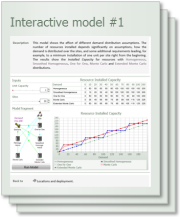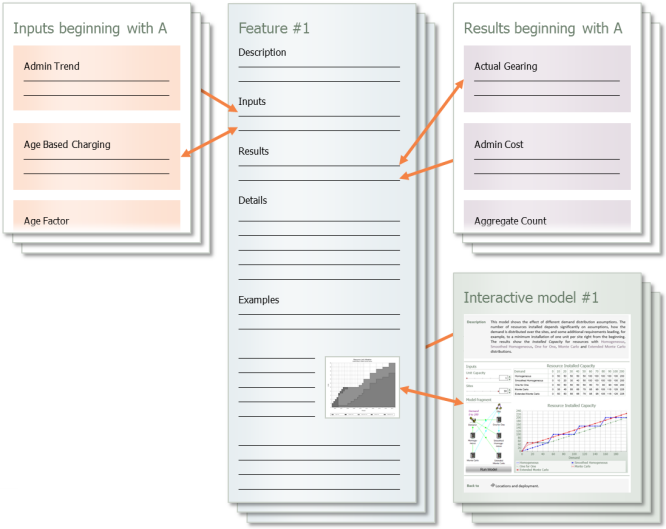 Six months ago we announced the release of an initial ten interactive example models
in our online help system at
help.stem.impliedlogic.com.
Since then we have been working through the rest of the
Model features section, developing
(more precisely) a further 52 models designed to bring to life the various static
examples and figures in the original text. In parallel, we have also reviewed the
structure of the whole section under a new heading of
Calculation framework.
Six months ago we announced the release of an initial ten interactive example models
in our online help system at
help.stem.impliedlogic.com.
Since then we have been working through the rest of the
Model features section, developing
(more precisely) a further 52 models designed to bring to life the various static
examples and figures in the original text. In parallel, we have also reviewed the
structure of the whole section under a new heading of
Calculation framework.
Finally we are pleased to announce the publication online of this new structure, together with the complete set of models which you can explore yourself (no registration required) if you want to learn more about how STEM works or simply evaluate its potential.
New-look calculation framework
The section formerly known as Model features is a self-contained reference to all of the built-in calculations made by STEM. Indeed it was even a separate binder in the days when we still shipped hard-copy manuals! As ever, each group of calculations is explained in detail with examples, and is cross-referenced with alphabetical listings of every pre-defined input and result. (The inputs are also presented by data dialog in the alternative context of the Editor skills section, which is where pressing <F1> in the Editor takes you, and these pages also link through to the associated features.)
This structure is now augmented with the new interactive models which exist in parallel to the static feature topics. Each model is linked (both ways) from an original example or figure in the feature section, and you can also browse from one model to the next for more of a ‘try it and see’ experience.

Figure 1: Structure of the new Calculation framework section
Try before you buy and see how it works
The library of interactive help models is still growing and will be maintained as
a living resource. We expect to add further commentary and illustrations as appropriate,
and to make individual models available for download in due course.
The 52 new models alone would serve as a useful weekly self-training exercise to
learn STEM ‘from cover to cover’ over the course of an aspirational
year. We may even add a Help model of the week feature
to our main website to promote wider awareness of this rich opportunity. The current
list of titles is shown in Figure 2 below.
Evidently the principal aim of these models is to serve the learning process as an extension of the original help content. However, the readily-accessible interactive format also facilitates ‘self-service’ evaluation of the system before buying.
Seeing is believing
The Internet-connected STEM platform has been used and verified internationally for years already, but what better evidence of our confidence in the system could we present than this comprehensive set of openly-accessible test models? Each of the ‘nuts and bolts’ shown here is an element you can rely on in a critical business-case model, and one which you won’t have to design, code or test to a deadline yourself.
| Time Factor transformation 01 |
Fixed Assets |
| Time Factor transformation 02 |
Leased Facilities |
| Consumable resource contractor costs |
Overheads |
| Stock of consumable resources |
Cost Period |
| Consumption of energy in time |
Resource decommissioning |
| Matching hours to engineer capacity |
Resource decommissioning Use Slack |
| Technology shift |
Resource decommissioning Make Slack |
| Customer churn |
Resource deployment |
| Churn through transformations |
Resource deployment Maximum Utilisation |
| Direct and used cost results |
Resource deployment Minimum Slack Capacity |
| Allocating costs of slack capacity |
Minimum Slack Capacity and Maximum Utilisation |
| Cost dependent tariff |
Resource deployment Proactive installation |
| Production Functions |
Resource requirements 01 |
| Cost Trends |
Resource requirements 02 |
| Age Factors |
Service administrative costs |
| Demand |
Shorter time periods |
| Demand Traffic Volume |
Tariffs and revenues |
| Depreciation |
Tariff feedback to demand 01 |
| Residual Value |
Tariff feedback to demand 02 |
| Depreciation Schedule |
Input output mapping transformation 01 |
| Calendar Override |
Input output mapping transformation 02 |
| Erlang B formula |
Expression transformation 01 |
| Erlang B with Deployment |
Expression transformation 02 |
| Discount Rate |
Previous transformation |
| IRR |
Time Lag transformation |
| Financing and Debt Facilities |
Delta transformation 01 |
| Sourcing incremental borrowing |
Delta transformation 02 |
| Locations and deployment |
Cumulative Sum transformation 01 |
| Pre Run Installation 01 |
Cumulative Sum transformation 02 |
| Pre Run Installation 02 |
Value chain analysis |
| Pre Run Installation 03 |
Working Capital |
Figure 2: Listing of interactive help models for STEM as at 31 July 2015 (in order of the original examples)
If you are still reading down to here, perhaps you would care to share this article
or a link to the Calculation framework section
with the hashtag #HelpModelOfTheWeek?